
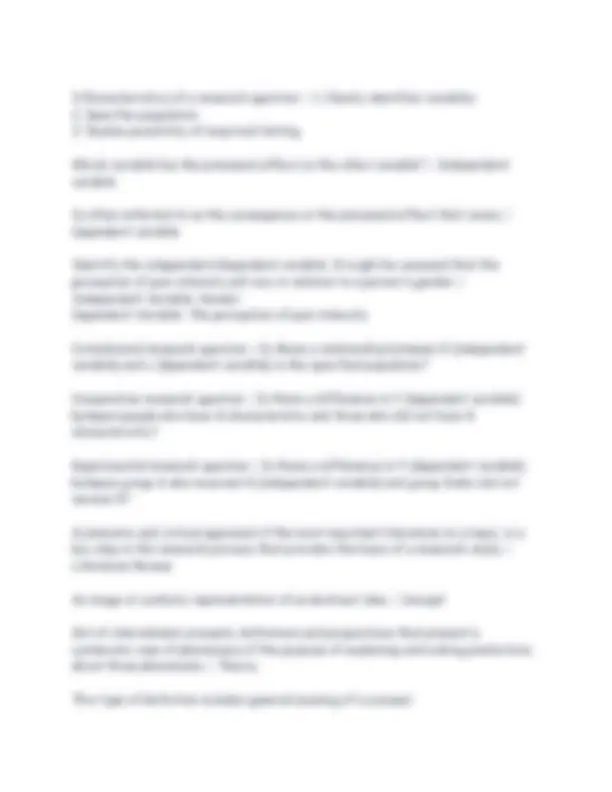
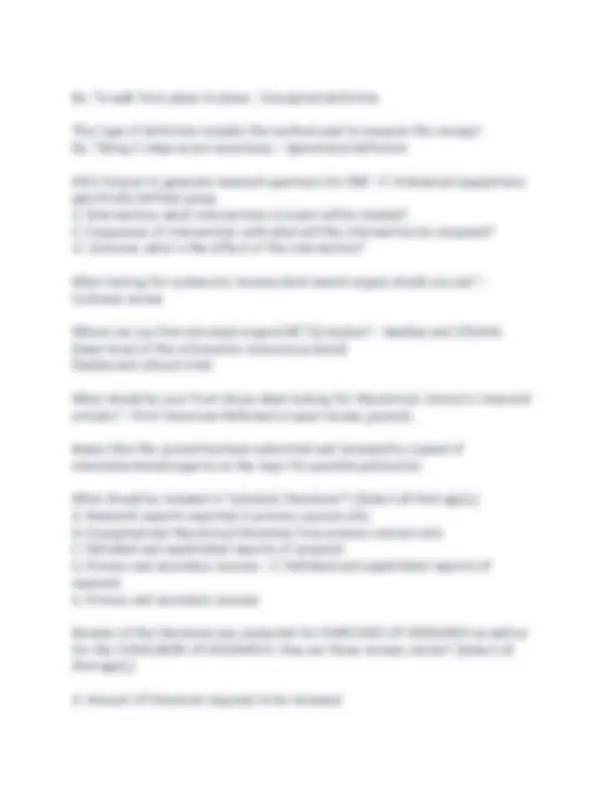
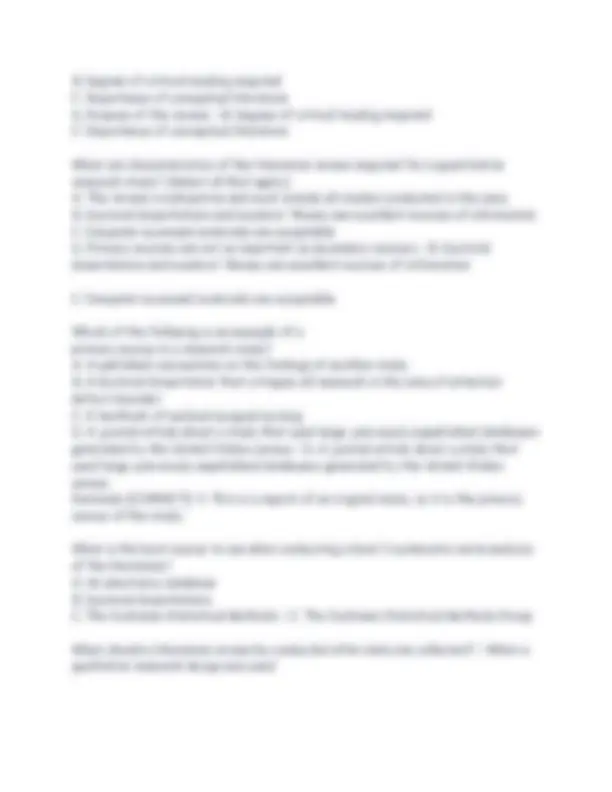
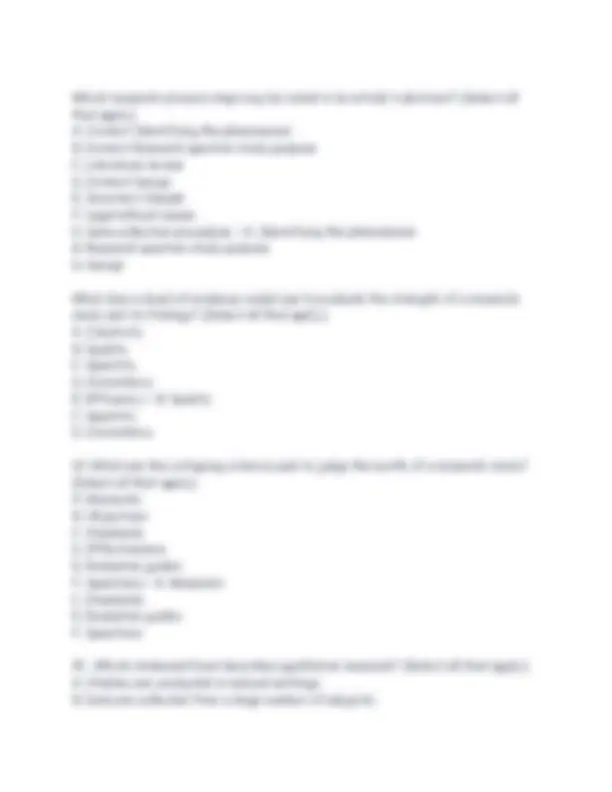
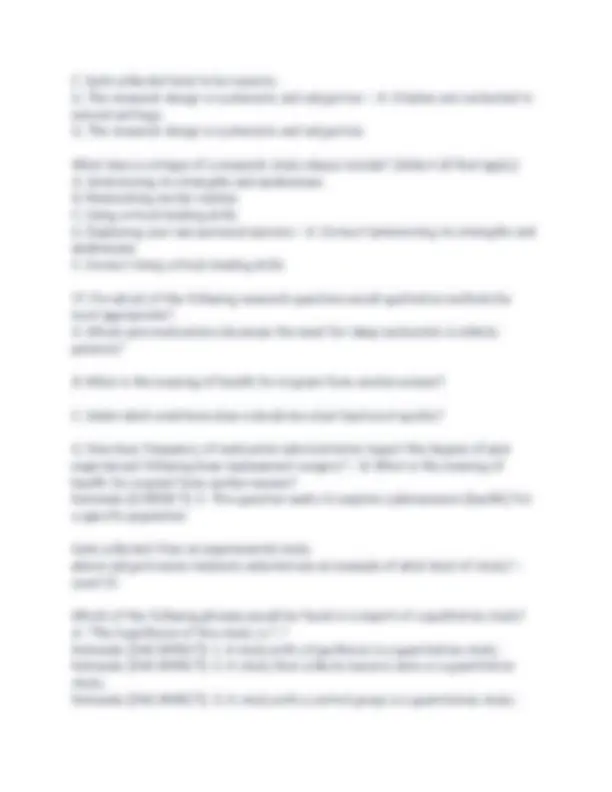
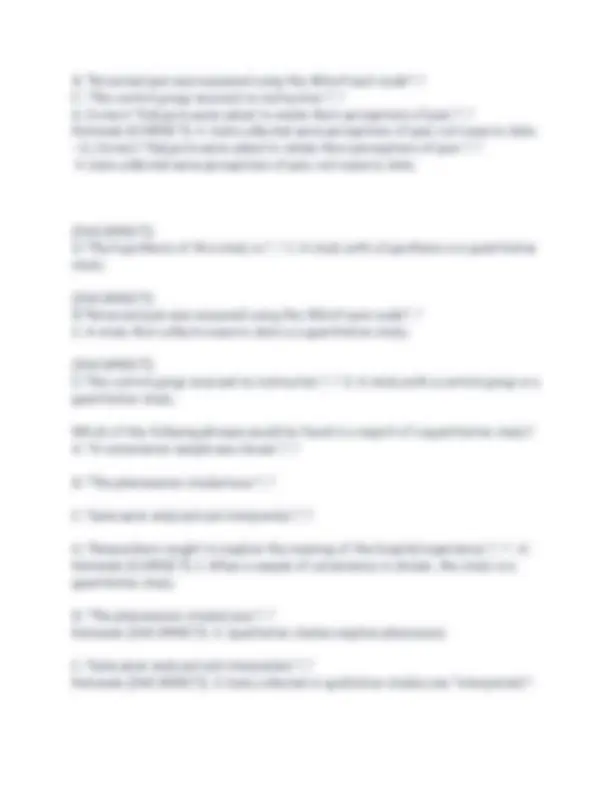
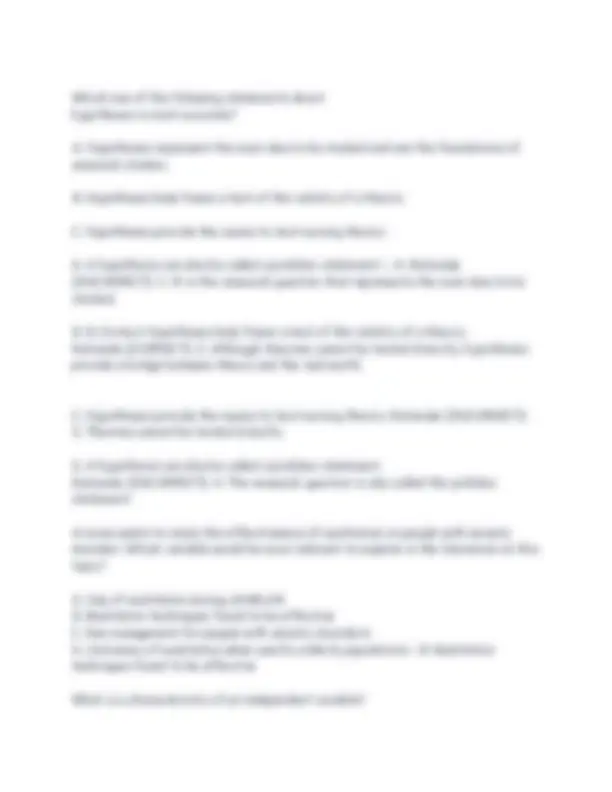
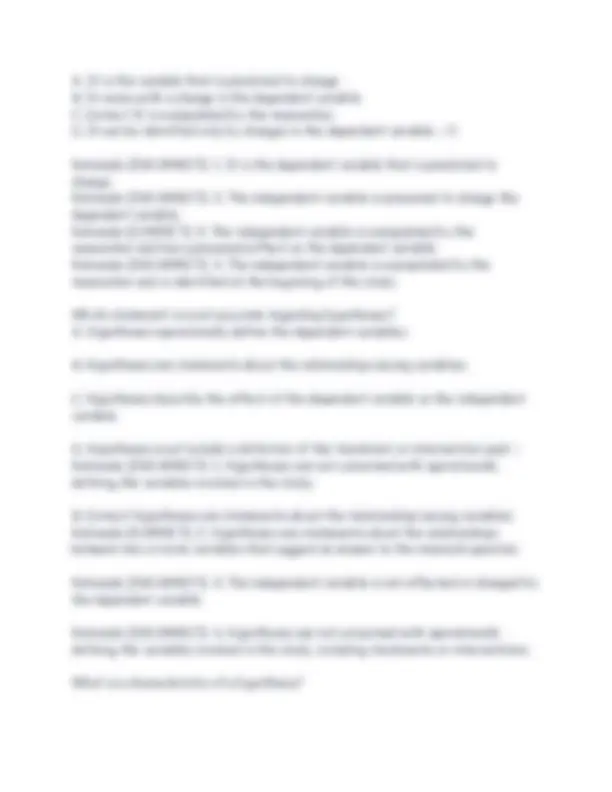
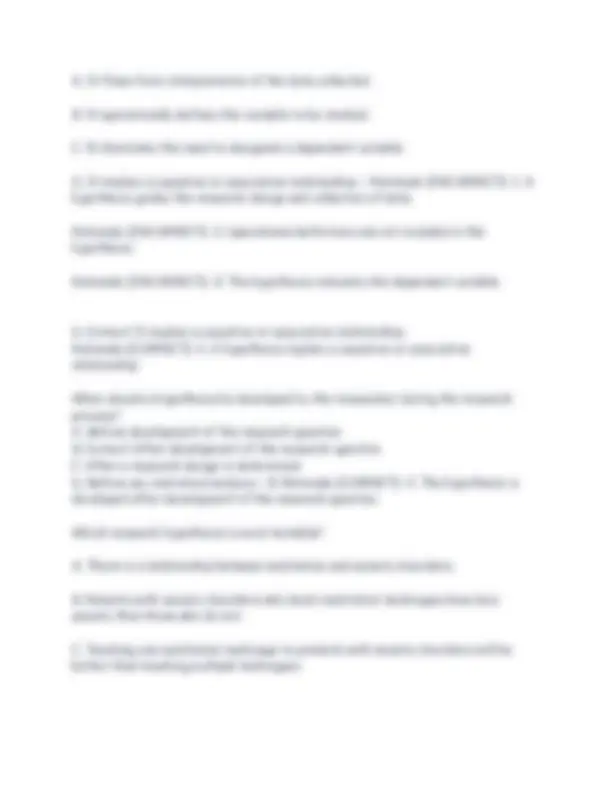
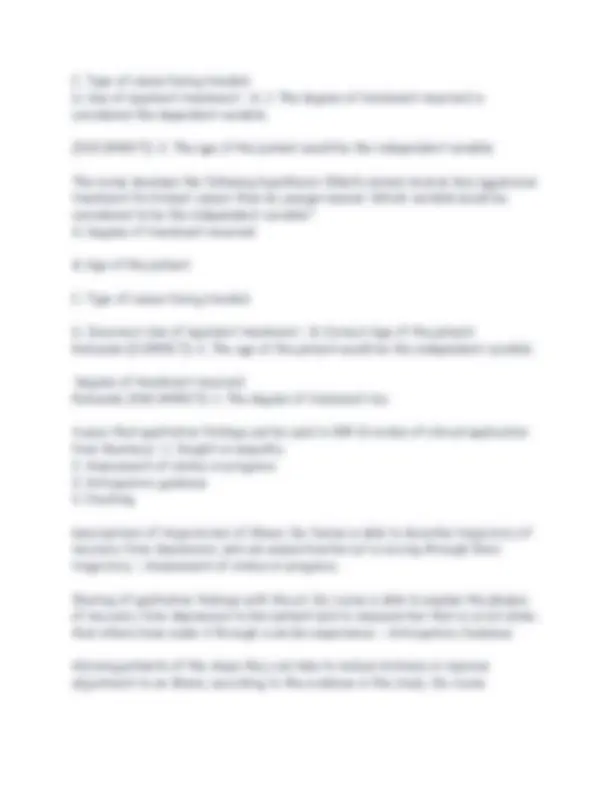
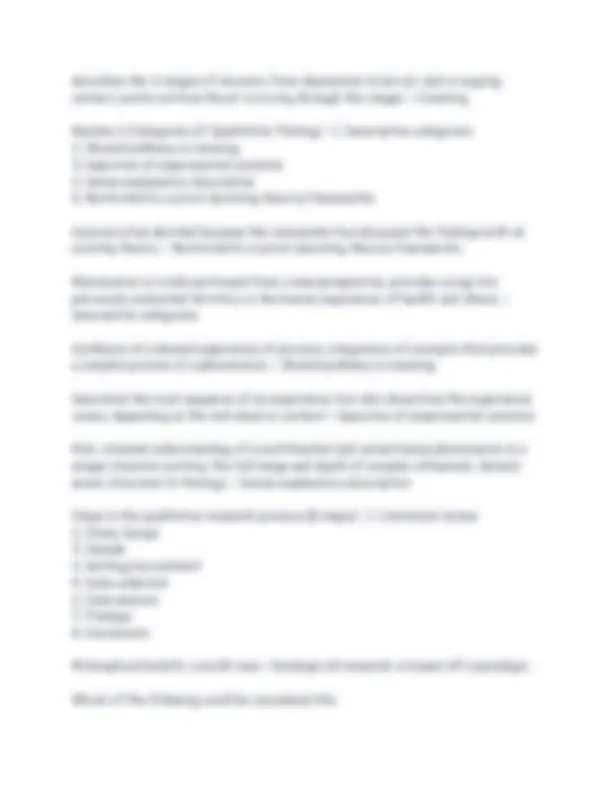
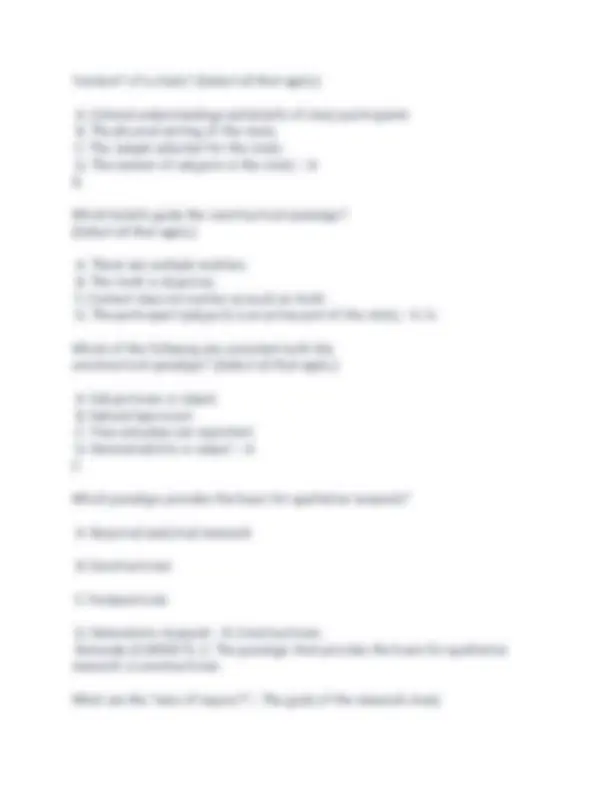
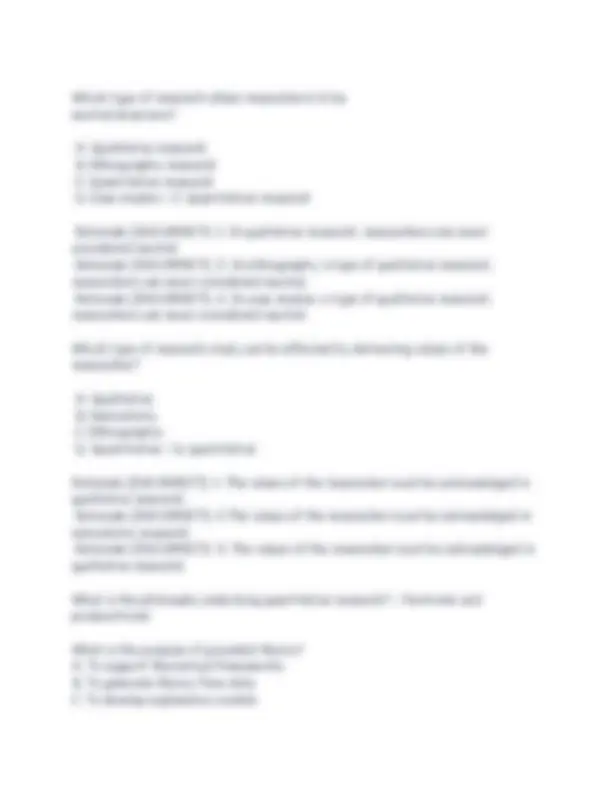
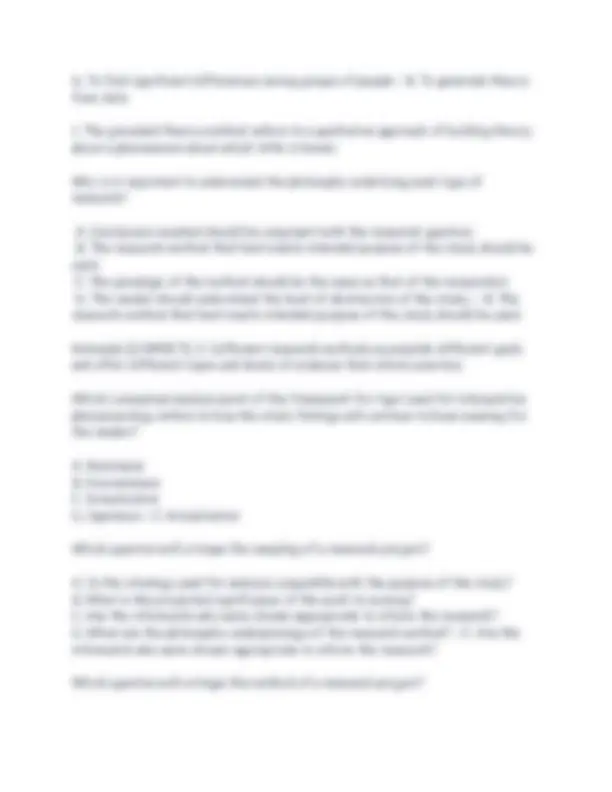
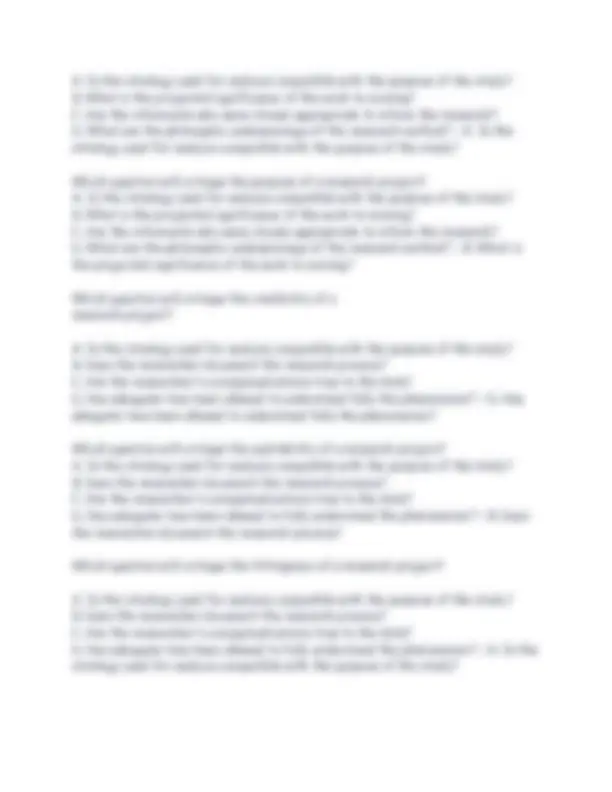
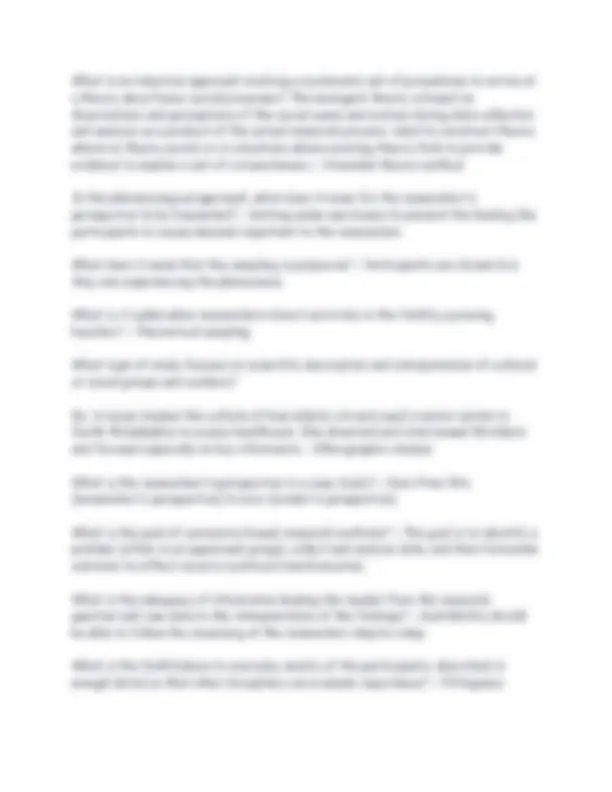
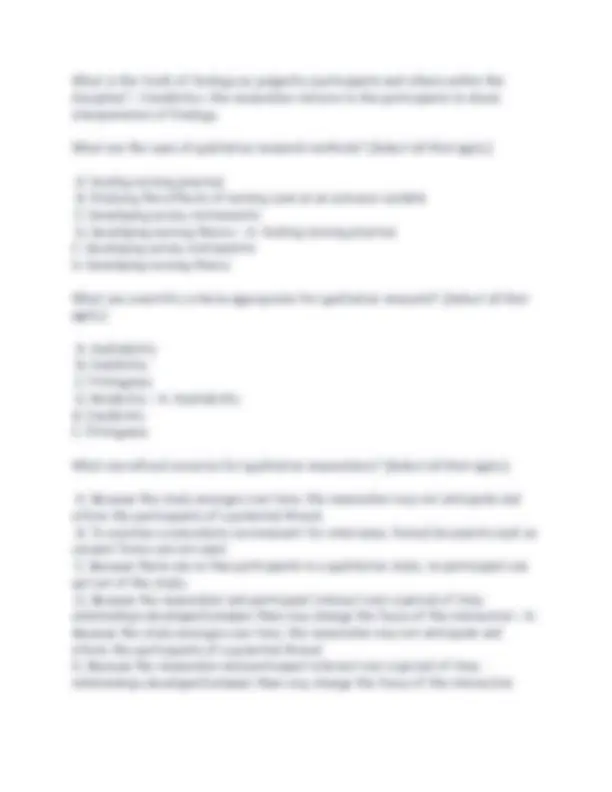
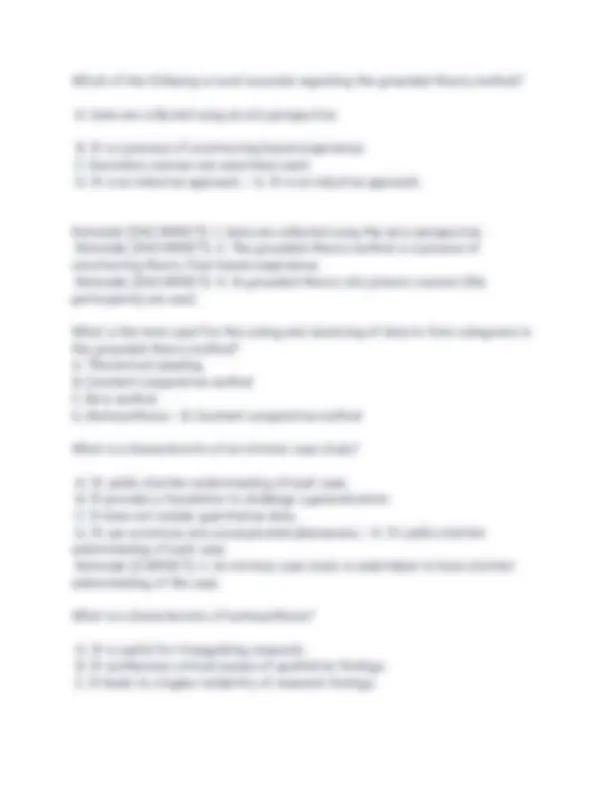
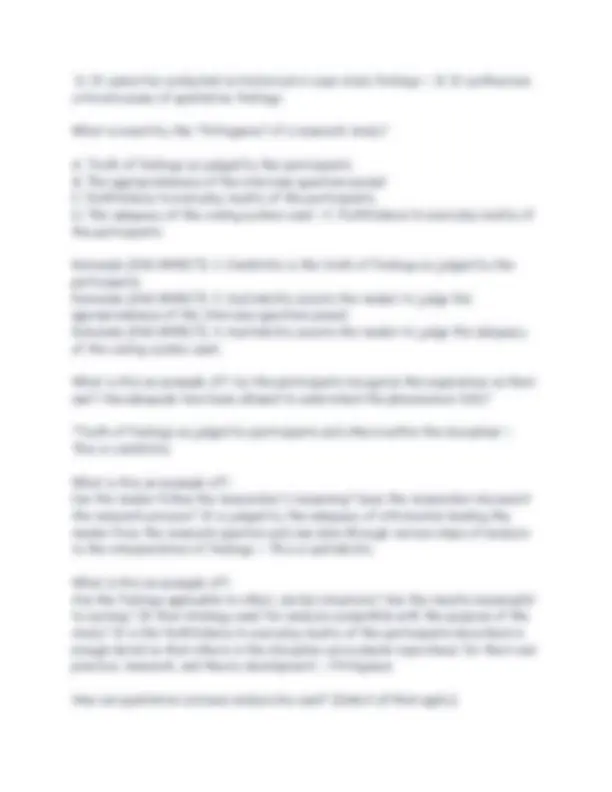
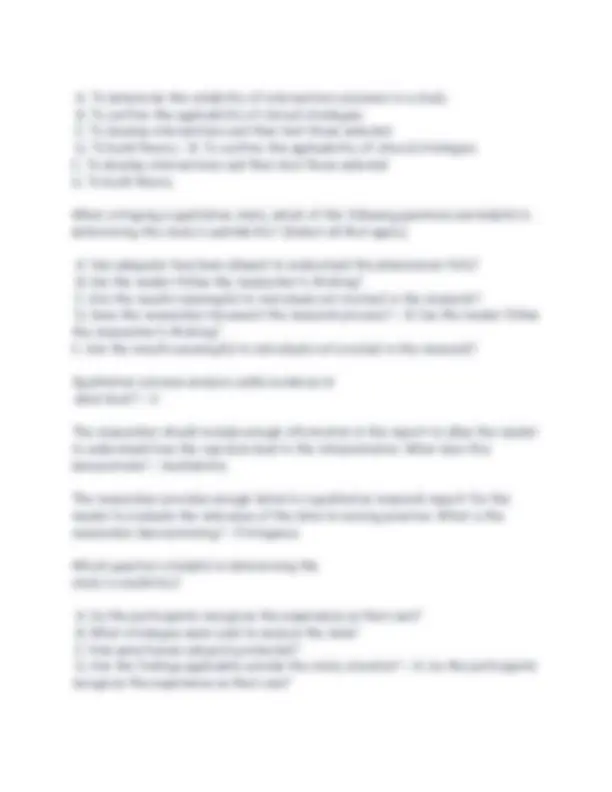

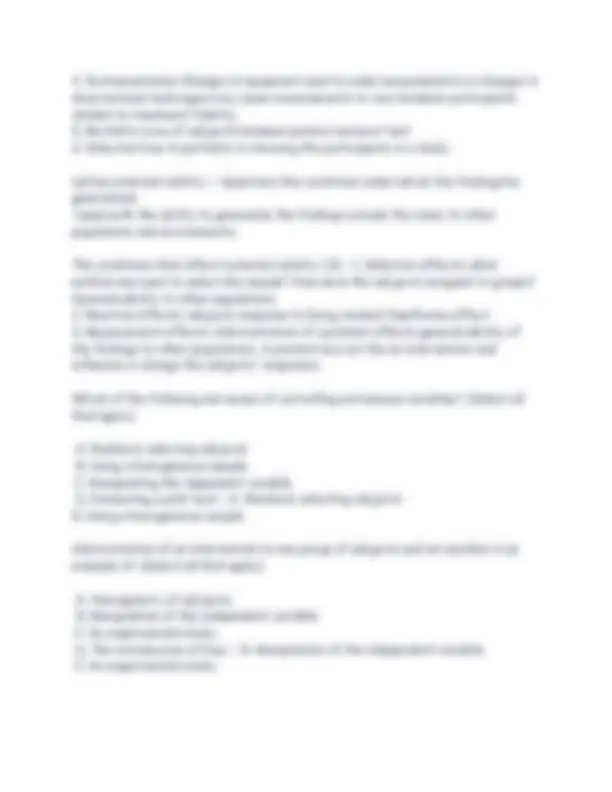

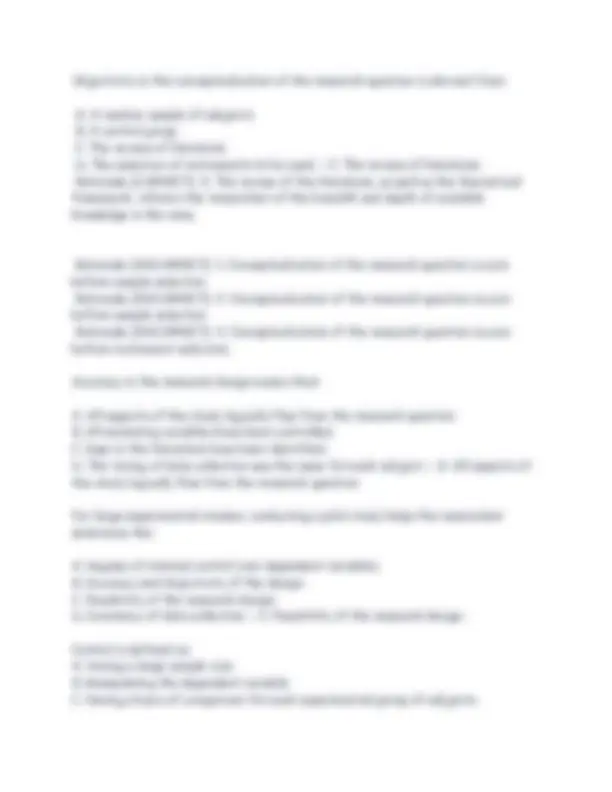
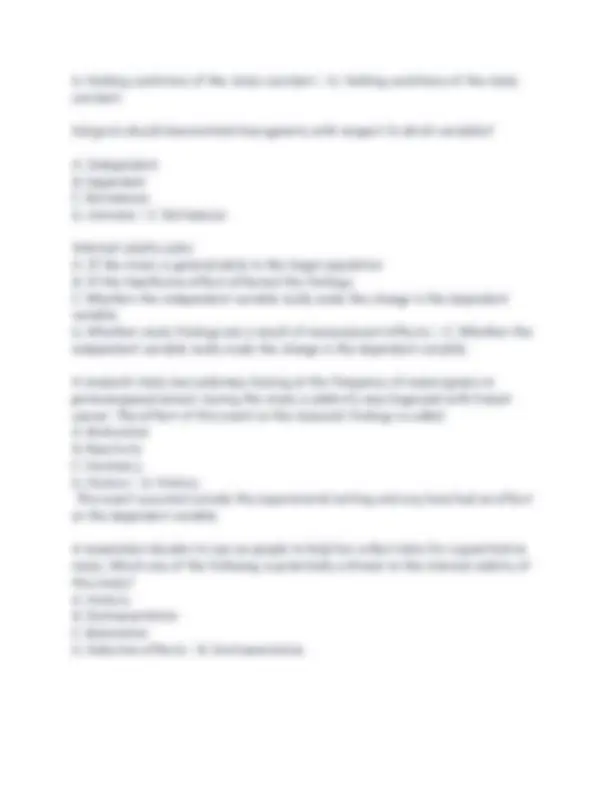
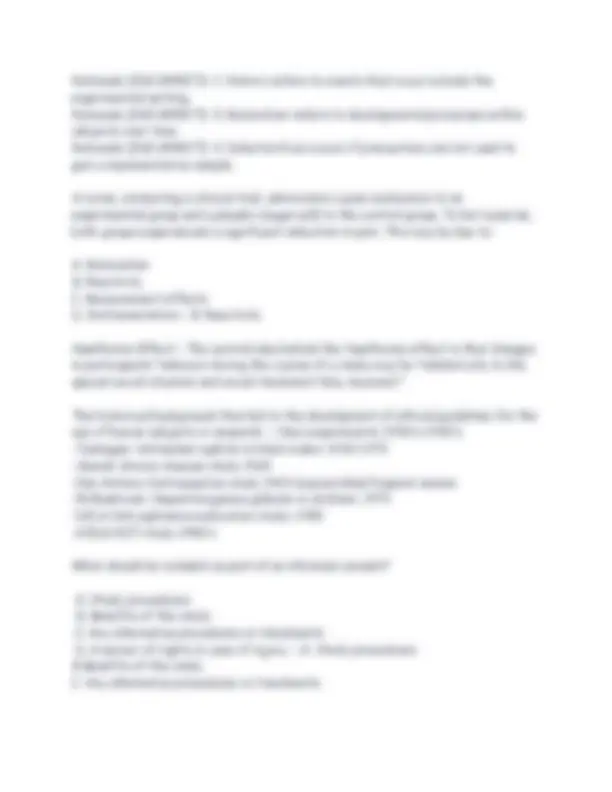
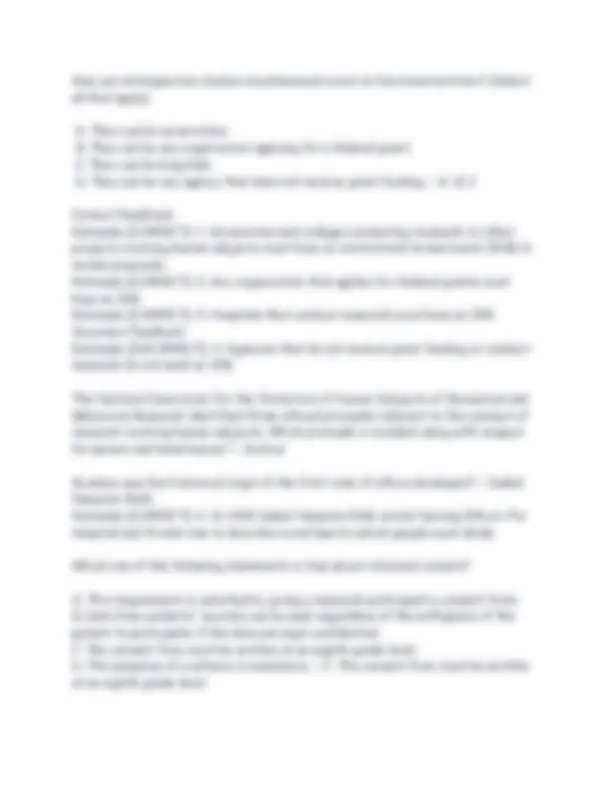
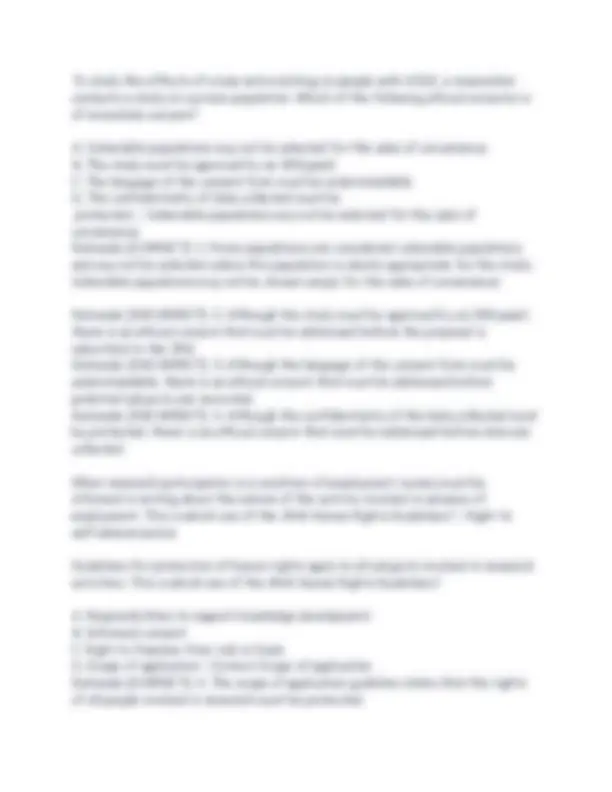
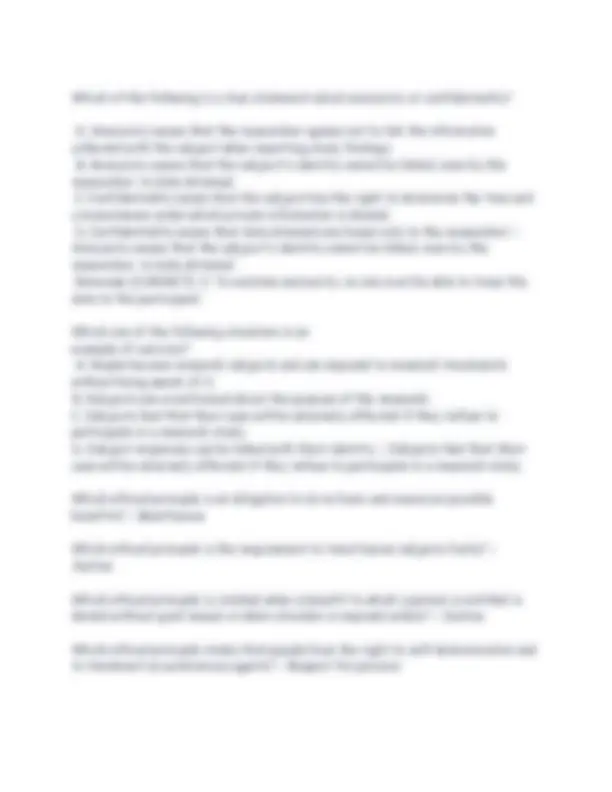
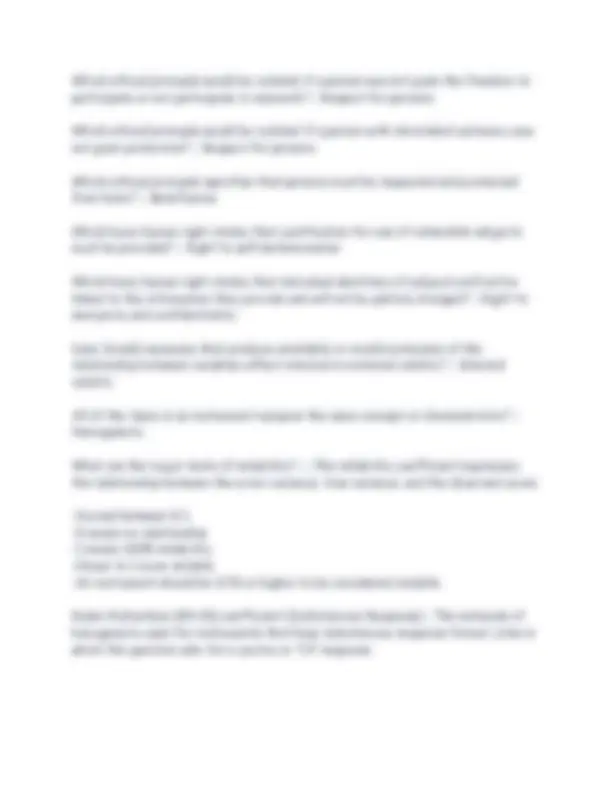

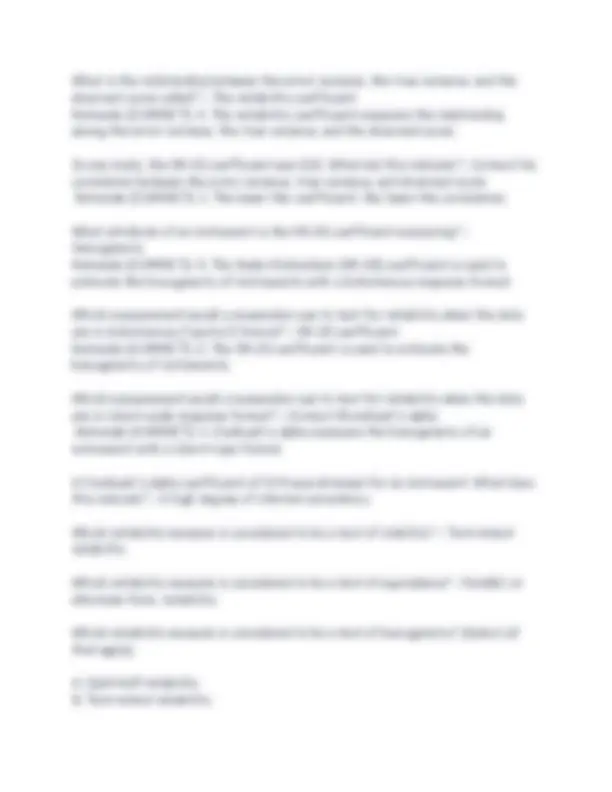
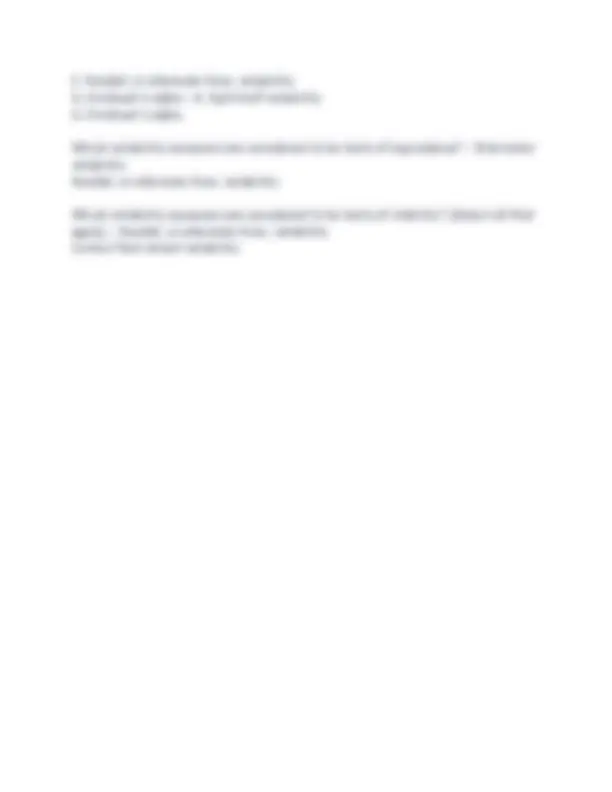


Study with the several resources on Docsity

Earn points by helping other students or get them with a premium plan


Prepare for your exams
Study with the several resources on Docsity

Earn points to download
Earn points by helping other students or get them with a premium plan
Community
Ask the community for help and clear up your study doubts
Discover the best universities in your country according to Docsity users
Free resources
Download our free guides on studying techniques, anxiety management strategies, and thesis advice from Docsity tutors
Covers essential concepts in nursing research, including methods, ethics, hypothesis testing, and more Perfect for test prep and nursing exams. Ideal for nursing students preparing for their first research exam!
Typology: Exams
1 / 41

This page cannot be seen from the preview
Don't miss anything!


































Guided by research questions and data are collected from a small number of subjects allowing an in depth study of phenomenon - Qualitative Describes phenomena seeks to test hypothesis/ answer research questions using statistical methods - Quantitative Meta-Synthesis - A synthesis of a number of qualitative articles on a focused topic using specific qualitative methodology. Integrative review - Focused review and synthesis of the literature on a specific area that follows specific steps of literature integration and synthesis without statistical analysis. Meta-analysis - Summarizes a number of studies focused on a topic using a specific statistical methodology to synthesize the findings in order to draw conclusions about the area of focus. 4 strategies for critical reading: - 1. Preliminary
Level 2 - A well-designed RCT Level 3 - Quasiexperimental study -Controlled trial WITHOUT randomization Level 4 - Single non-experimental study (case-control, correlational, cohort studies. Level 5 - Systematic reviews of descriptive and QUALITATIVE studies Level 6 - Single descriptive or QUALITATIVE studies Level 7 - Opinion of authorities and/or reports of expert committees. What presents the idea that is to be examined in the study and is the foundation of the research study - The research question What attempts to answer the research question - The hypothesis What are the 4 components of clinical questions? - 1. Population
Ex: To walk from place-to-place - Conceptual definition This type of definition includes the method used to measure the concept. Ex: Taking 4 steps w/out assistance - Operational definition PICO format to generate research questions for EBP - P: Problem/pt populations; specifically defined group I: Intervention; what interventions or event will be studied? C: Comparison of intervention: with what will the intervention be compared? O: Outcome; what is the effect of the intervention? When looking for systematic reviews what search engine should you use? - Cochrane review Where can you find individual original (RCTs) studies? - Medline and CINAHL (lower level of the information resource pyramid) Randomized clinical trials What should be your first choice when looking for theoretical, clinical or research articles? - Print resources-Refereed or peer-review journals. Means that the journal has been submitted and reviewed by a panel of internal/external experts on the topic for possible publication. What should be included in "scholarly literature"? (Select all that apply.) A. Research reports reported in primary sources only B. Conceptual and theoretical literature from primary sources only C. Published and unpublished reports of research D. Primary and secondary sources - C. Published and unpublished reports of research D. Primary and secondary sources Reviews of the literature are conducted for PURPOSES OF RESEARCH as well as for the CONSUMER OF RESEARCH. How are these reviews similar? (Select all that apply.) A. Amount of literature required to be reviewed
B. Degree of critical reading required C. Importance of conceptual literature D. Purpose of the review - B: Degree of critical reading required C: Importance of conceptual literature What are characteristics of the literature review required for a quantitative research study? (Select all that apply.) A. The review is exhaustive and must include all studies conducted in the area B. Doctoral dissertations and masters' theses are excellent sources of information C. Computer-accessed materials are acceptable D. Primary sources are not as important as secondary sources - B. Doctoral dissertations and masters' theses are excellent sources of information C. Computer-accessed materials are acceptable Which of the following is an example of a primary source in a research study? A. A published commentary on the findings of another study B. A doctoral dissertation that critiques all research in the area of attention deficit disorder C. A textbook of medical-surgical nursing D. A journal article about a study that used large, previously unpublished databases generated by the United States census - D. A journal article about a study that used large, previously unpublished databases generated by the United States census Rationale (CORRECT): 4. This is a report of an original study, so it is the primary source of the study. What is the best source to use when conducting a level I systematic meta-analysis of the literature? A. An electronic database B. Doctoral dissertations C. The Cochrane Statistical Methods - C. The Cochrane Statistical Methods Group When should a literature review be conducted after data are collected? - When a qualitative research design was used
Structure of concepts and/or theories that provides the basis for development of research questions or hypotheses - Conceptual or theoretical framework -For example in a study investigating the effect of a psychoeducational telephone counseling intervention on the quality of life (QoL) for breast cancer survivors, QOL was the conceptual framework used ot guide the identification and development of the study. -QOL was conceptually defined as "a multidimensional construct consisting of four domains: physical, psychosocial, social and spiritual well-being." -Each domain contributes to overall quality of life and was operationally defined as the score on the Quality of Life-Breast cancer survivors measurement instrument. What is the overall purpose of the literature review? - The overall purpose of the literature review is to present a strong knowledge base for the conduct of the research study. As students what should be our first choice when looking for theoretical, clinical, or research articles? - Refereed or peer-reviewed journals Refereed or peer-reviewed journals - Refeered or peer-reviewed journals have a panel of internal and external reviewers who review submitted manuscripts for possible publication. The external reviewers are drawn from a pool of nurse scholars, and possibly scholars from other related disciplines who are experts in various specialties. In most cases, the reviews are "blind"; that is, the manuscript to be reviewed does not include the name of the author(s). In contrast to quantitative studies, the literature reviews of qualitative studies are usually handled in a different manner. How is this so? - -There is often little known about the topic under study. The literature may be conducted at the beginning of the study or after that data analysis is completed with qualitative. Why is nursing research valuable to the consumers of health care? - Correct Research provides evidence that nursing care makes a difference. What is the purpose of the World Health Organization (WHO)'s designated Collaborating Centers throughout the United States? - To provide research and clinical training in nursing to colleagues around the globe How is evidence-based practice derived? - From research on patient outcomes
Which research process steps may be noted in an article's abstract? (Select all that apply.) A. Correct Identifying the phenomenon B. Correct Research question study purpose C. Literature review D. Correct Design E. Incorrect Sample F. Legal-ethical issues G. Data-collection procedure - A. Identifying the phenomenon B. Research question study purpose D. Design What does a level-of-evidence model use to evaluate the strength of a research study and its findings? (Select all that apply.) A. Creativity B. Quality C. Quantity D. Consistency E. Efficiency - B. Quality C. Quantity D. Consistency
B. "Perceived pain was measured using the Abbott pain scale? ." C. "The control group received no instruction? ." D. Correct "Subjects were asked to relate their perceptions of pain? ." Rationale (CORRECT): 4. Data collected were perceptions of pain, not numeric data.
D. Rationale (INCORRECT): 4. Qualitative studies explore the meaning of human experience. A nurse researcher develops the following research question: Is there a relationship between anxiety and body weight in premenopausal and postmenopausal women? Which type of research question format is this considered to be? - Correlational A nurse researcher develops the following research question: Do menopausal women who received daily doses of an herbal hormone treatment report a lesser number of hot flashes than women who did not receive the treatment? Which type of research question format is this considered to be? - Comparative Which of the following hypotheses are indicative of an experimental research design? (Select all that apply.) A. Frequent irrigation of Foley catheters will be positively related to urinary tract infections. B. The incidence of urinary tract infections will be greater in patients whose Foley catheters are irrigated frequently than in those whose Foley catheters are irrigated less frequently. C. Frequent irrigation of Foley catheters is associated with urinary tract infections. D. The incidence of urinary tract infections will not differ between patients with or without Foley catheters. - B. Correct The incidence of urinary tract infections will be greater in patients whose Foley catheters are irrigated frequently than in those whose Foley catheters are irrigated less frequently. D. Correct The incidence of urinary tract infections will not differ between patients with or without Foley catheters. Which statements are part of the criteria used to judge the soundness of a stated research question? (Select all that apply.) A. A relationship between two or more variables
Which one of the following statements about hypotheses is most accurate? A. Hypotheses represent the main idea to be studied and are the foundations of research studies. B. Hypotheses help frame a test of the validity of a theory. C. Hypotheses provide the means to test nursing theory. D. A hypothesis can also be called a problem statement. - A. Rationale (INCORRECT): 1. It is the research question that represents the main idea to be studied. B. B. Correct Hypotheses help frame a test of the validity of a theory. Rationale (CORRECT): 2. Although theories cannot be tested directly, hypotheses provide a bridge between theory and the real world. C. Hypotheses provide the means to test nursing theory. Rationale (INCORRECT):
A. It is the variable that is predicted to change. B. It varies with a change in the dependent variable. C. Correct It is manipulated by the researcher. D. It can be identified only by changes in the dependent variable. - C. Rationale (INCORRECT): 1. It is the dependent variable that is predicted to change. Rationale (INCORRECT): 2. The independent variable is presumed to change the dependent variable. Rationale (CORRECT): 3. The independent variable is manipulated by the researcher and has a presumed effect on the dependent variable. Rationale (INCORRECT): 4. The independent variable is manipulated by the researcher and is identified at the beginning of the study. Which statement is most accurate regarding hypotheses? A. Hypotheses operationally define the dependent variables. B. Hypotheses are statements about the relationships among variables. C. Hypotheses describe the effect of the dependent variable on the independent variable. D. Hypotheses must include a definition of the treatment or intervention used. - Rationale (INCORRECT): 1. Hypotheses are not concerned with operationally defining the variables involved in the study. B. Correct Hypotheses are statements about the relationships among variables. Rationale (CORRECT): 2. Hypotheses are statements about the relationships between two or more variables that suggest an answer to the research question. Rationale (INCORRECT): 3. The independent variable is not affected or changed by the dependent variable. Rationale (INCORRECT): 4. Hypotheses are not concerned with operationally defining the variables involved in the study, including treatments or interventions. What is a characteristic of a hypothesis?
D. The ability to meditate causes lower anxiety in patients with anxiety disorder than those who do not meditate. - D. The ability to meditate causes lower anxiety in patients with anxiety disorder than those who do not meditate. Rationale (CORRECT): 4. This hypothesis meets the criteria of testability. What is a characteristic of a statistical hypothesis? A. It is a null hypothesis. B. It predicts a positive relationship among variables. C. It is a complex hypothesis. D. It describes data-analysis methods. - A. Correct It is a null hypothesis. Rationale (CORRECT): 1. Statistical hypotheses, called null hypotheses, state that there is no relationship between the independent and dependent variables. When will a null hypothesis be rejected? A. There is no association among variables. B. There is evidence of significance. C. The independent and dependent variables are related. D. The research hypothesis is rejected. - C. Rationale (CORRECT): 3. Because the null hypothesis states that there is no relationship between the independent and dependent variables, it is rejected if they are related. Which level is characteristic of the strength of the evidence provided by the results of a quasi-experimental study? A. Level I B. Level II C. Level III D. Level IV - C. Level III Rationale (CORRECT): 3. Evidence provided by quasi-experimental studies is level III.
Rationale (INCORRECT): 1. Level I evidence is obtained from a systematic review of all randomized, controlled trials. Rationale (INCORRECT): 2. Level II evidence is obtained from at least one well- designed randomized, controlled trial. Rationale (INCORRECT): 4. Level IV evidence is obtained from nonexperimental studies. A researcher wants to discover why patients of certain ethnic backgrounds are reluctant to ask for pain medication. Because there are little data in the literature on this topic, the researcher designs a study to explore the relationships between cultural belief systems, the experience of pain, and the effective use of medication to relieve pain. The researcher plans to use the findings of this study to formulate hypotheses for a future study. What is a characteristic of this study? A. It is a quasi-experimental study. B. It will lead to level II data. C. It has a directional hypothesis. D. Correct It is a hypothesis-generating study. - D; Rationale (CORRECT): 4. Not enough is known in this area at this time to formulate hypotheses, so the researcher will conduct this qualitative study and use the findings to generate hypotheses for future studies. Rationale (INCORRECT): 1. This is a qualitative study, not a quasi-experimental study. Rationale (INCORRECT): 2. Level II evidence is obtained from at least one well- designed randomized, controlled trial. Rationale (INCORRECT): 3. This study has no hypothesis. The nurse develops the following hypothesis: Elderly women receive less aggressive treatment for breast cancer than do younger women. Which variable would be considered to be the dependent variable? A. Degree of treatment received B. Age of the patient
describes the 6 stages of recovery from depression to her pt, and in ongoing contact, points out how the pt is moving through the stages. - Coaching Kearney's Categories of Qualitative Findings - 1. Descriptive categories
"context" of a study? (Select all that apply.) A. Cultural understandings and beliefs of study participants B. The physical setting of the study C. The sample selected for the study D. The number of subjects in the study - A. B. Which beliefs guide the constructivist paradigm? (Select all that apply.) A. There are multiple realities. B. The truth is objective. C. Context does not matter as much as truth. D. The participant (subject) is an active part of the study - A. D. Which of the following are consistent with the constructivist paradigm? (Select all that apply.) A. Subjectivism is valued. B. Natural laws exist. C. Time and place are important. D. Generalizability is valued. - A. C. Which paradigm provides the basis for qualitative research? A. Empirical analytical research B. Constructivism C. Postpositivism D. Naturalistic research - B. Constructivism. Rationale (CORRECT): 2. The paradigm that provides the basis for qualitative research is constructivism. What are the "aims of inquiry"? - The goals of the research study